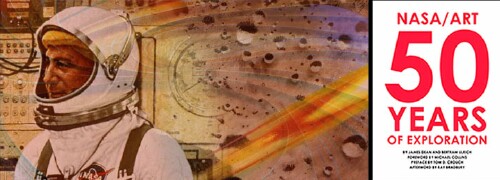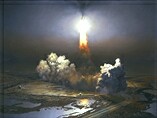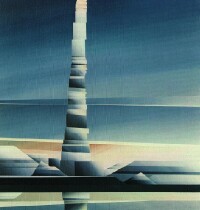Book Review: NASA/ART: 50 Years of Exploration

NASA/ART: 50 Years of Exploration is a newly released hardcover that provides a look at the space art produced through the NASA Art Program. The book's author - James D. Dean - was the founding director of the NASA Art Program and served as director from 1962 until 1974. Co-author Bertram Ulrich is Curator and Multimedia Manager at NASA. The cover illustration (not seen in the cover image shown) is a lenticular version of the painting "A Handful of Emeralds" by David Stone which features a Shuttle astronaut in a MMU (manned manuvering unit).
The book is divided into the following sections:
- Blazing the Trail: Mercury and Gemini
- On to the Moon: Apollo and Future Moon Missions
- Soaring to the Skys and Heavens: Aeronautics and the Shuttle Era
- New Worlds: Exploration Beyond Our Home Planet
In addition, the book contains a Foreword by Apollo 11 Command Module Pilot Astronaut Michael Collins; a Preface by Tom Crouch, Senior Curator of Aeronautics at the National Air and Space Museum, that provides a brief background on the NASA Art Program; and afterword by noted science fiction author Ray Bradbury.
My favorite quote from the book come courtesy of Apollo 11 Astronaut Collins in the Foreword:
"As the lovely work in this book illustrates, the eye of the artist fills the great gaps left by the astronaut and his camera."
Blazing the Trail: Mercury and Gemini
This section of the book is the most historically interesting in that it documents the birth of the American space program. My favorite painting in this section is VAB Bay by Lowell Nesbitt, a 60 by 60 inch oil on canvas depicting a downward looking view of the work platforms surrounding the Saturn V rocket in the VAB (Vehicle Assembly Building). Nesbitt's combination of color and line creates a wonderful abstract effect.
Also very visually interesting is the photoreal quality of Knight's Armor (The End of the Beginning) by Paul Calle. This oil on panel has as its subject the space suit, gloves, and helmet of Mercury astronaut Gordon Cooper with each item posed separately against a white linen background and lit from the side.
On to the Moon: Apollo and Future Moon Missions
On first opening the book the section that held the most excitement for me was that which documented the Apollo voyages to the Moon. Surprisingly, the piece I found most visually appealing was an abstract titled Moon, Horizon, and Flowers (Rocket Rollout), an oil on canvas by Jack Perlmutter.
The art with what I would characterize as the best message was a piece by Norman Rockwell. Behind Apollo 11 an oil on canvas from 1969 has the astronauts in the left foreground looking upward off canvas to the left. Also in the foreground to the right of the astronauts are representations of the many people who made the Apollo missions possible. The message is clear: the Apollo missions to the Moon were not just a voyage accomplished by the astronauts, but was a collective voyage that took many hands working together to accomplish.
Fig 1.
My favorite traditional space art piece is a work by Pierre Mion (Fig 1 at right). A Speck of Dust is a large 120 by 40 inch vertically oriented oil on canvas. On the NASA Copernica space art web site, this piece is titled Astronauts Explore the Moon so I am not certain which is the correct title. The piece depicts a pair of astronauts exploring the lunar surface. In the scene, the astronauts are tiny figures at the bottom of the image dwarfed by the surrounding lunar surface that extends nearly to the top of the image with just a sliver of black sky with the Earth just over the horizon as a small distant orb.
Soaring to the Skys and Heavens: Aeronautics and the Shuttle Era

Fig 2.
The focus of this section is on aviation and the Space Shuttle program. The quality of the art in this section is somewhat erratic but also features some of the best art in the book with my favorites being paintings of Space Shuttle launches.
I was not surprised to see The Light Ship by Attila Hejja included (Fig 2). This is perhaps my favorite depiction of a shuttle launch. The painting is done from an elevated viewpoint from a distance of perhaps a mile or so. The light created by the firing of the Shuttle's engines beautifully illuminates the scene, especially the rocket exhaust clouds.

Fig 3.
I was also not surprised to see Florida Coast - Fire Pillar (Fig 3). This acrylic on canvas by James Cunningham is an abstract depiction of a shuttle launch using colors and a blocky style that reminds me of the geological formations of the American southwest. Note that the image shown here, and taken from the NASA Space Educator's Handbook web site, has a bluish cast.
What I found surprising was the inclusion of a couple works of art that I had never seen before. Servicing Hubble (Fig 4) by John Solie is a 53 by 36 inch oil on canvas that depicts the December 1992 Hubble Space Telescope service mission. The artwork shows astronaut Kathryn Thornton perched on the end of the RMS along side the Hubble Space Telescope with the Earth looming large in the background.

Fig 4.
The mixed media painting "Columbia Launch Fantasy" by Andreas Nottebohm is a luminous depiction of the shuttle leaving the atmosphere with the Moon faintly visible behind an intervening cloud layer making this a rather unique interpretation of a shuttle launch.
New Worlds: Exploration Beyond Our Home Planet
The art present in the New Worlds portion of the book fell far short of my expectations. I was expecting there to be visionary representations of the solar system, galaxy, and universe given the decades worth of imaging data returned by NASA's many planetary and astronomical satellite missions. My favorite work of art in this section is Mars Rover by Judith Eisler. This oil on linen is a wonderful impressionistic depiction of the Martian atmospheric entry of one of the Mars Exploration Rover spacecraft, complete with plasma trail.
The only other artwork that caught my eye was Titan by Daniel Zeller. An ink on paper, this work caught my eye primarily because it is so similar in style to that form of algorithmic art referred to as generative art.
Conclusion
As space art books go, I was very pleased with the way in which this book covered the art created as a part of the NASA Art Program. Altogether there are approximately 150 works of space art in the book. Other artists whose work appears in the book are Alexander Calder, Annie Leibovitz, Robert Rauschenberg, Andy Warhol, and James Wyeth. All in all, NASA/ART: 50 Years of Exploration makes a fine addition to any space art book collection.
Related Online Space Art Resources
NASA and the Arts is an article done as a part of a collection of materials associated with NASA's 50 year anniversary.
NASA/ART: 50 Years of Exploration is a NASA Flash gallery that contains images of 15 works of art that appear in the book.
NASA Copernica Space Art Gallery features an extensive collection of art produced as a part of the NASA Art Program. Unfortunately only small thumbnail size versions of the art are provided so no detail can be made out in any of the art. All but one of the images shown in association with this article was taken from Copernica.
Marshall Space Flight Center Art Collection 1960 to 2001 features a collection of space art in the possession of the NASA Marshall Space Flight Center. The images shown in this gallery are of a reasonable size, as compared with those in the Copernica gallery.
NASA Space Educators' Handbook Space Art Home Page features a nice collection of space art with reasonably sized images. The collection is broken down into the following categories:
- Mercury Program Space Art
- Gemini Program Space Art
- Apollo Program Space Art
- Space Shuttle Program Space Art
- Advanced Exploration Art
"The painters' eyes record events of space exploration with a wider range of emotional mood, a more intimate human response, and more unexpected perspectives than the abundant photos in the NASA collections."
William Hartmann, Scientist, author and astronomical artist